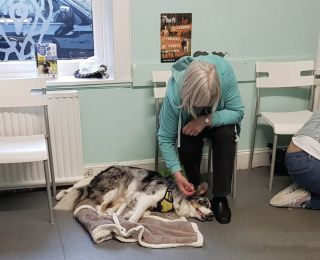Small animal - January 2019
Resilience in dogs: the importance of early positive socialisation
Building resilience, confidence, and social skills in puppies is essential to prevent behavioural problems later in life. It is important that this begins as early as possible with the breeder and continues with the owner, otherwise critical learning and developmental stages will elapse, writes Rachel Malkani MSc BSc (Hons) LSHC-S CDBC, a PhD student in Veterinary Medicine and Science at the University of Surrey
Positive exposure to a variety of sensory stimuli, paired with an adaptable socialisation plan that considers the dog’s individual traits, can be the difference between a well-socialised, happy dog, and a fearful, problematic dog. Positive experiences during the developmental period can increase dogs’ ability to cope with stressors later in life.
In puppies, the neonatal period lasts from birth until the puppy is approximately three weeks of age. During this time, their sensory capabilities are not yet fully developed, and are reliant on their mother’s care (Howell et al, 2015). Up until 12 weeks of age is a sensitive period for socialisation. This is a critical time in a puppy’s development for creating resilience in later life. Puppies need to be exposed to a variety of different environments, sounds, smells, people, other animals, dogs, handling, textures and tactile stimuli in a safe and positive manner. Conversely, a lack of interaction and an under-stimulating environment can have a life-long negative impact.
Building the foundations
Fox and Stelzner (1966) exposed puppies to handling and a variety of sensory stimuli for the first five weeks of life. Compared to control and isolated groups, handled puppies were reported to be more social and exploratory. Handled puppies also performed greater in a problem-solving task. Control groups displayed greater distress in a novel environment; however, showed less distress when isolated. Gazzano et al (2008) similarly examined early life experience on the emotional stability of puppies in later life. From the third day of life to the 21st, puppies were exposed to handling of all body parts. After eight weeks, handled puppies showed lower levels of reactivity, were more exploratory and social, and ‘calmer’ when isolated. These studies demonstrate that early life experience/handling is a fundamental need for puppies to facilitate resilience later in life and cope better in novel situations.
Educating owners and breeders about the importance of positive early socialisation is crucial to creating resilient dogs. This will not only reduce the likelihood of the dog experiencing behaviour problems later in life, dogs will be more accepting of handling and procedures in veterinary practice. Ideally, when puppies are around three weeks of age, breeders should be exposing their puppies to a wide variety of sensory (tactile, olfactory, auditory) stimuli at low levels, then gradually increasing the intensity. Following on from this, breeders should be incrementally exposing their puppies to a range of different people, animals, and environments in a safe and controlled manner; it is essential to slowly expose puppies to different stimuli in this way as exposing puppies too fast (flooding), where they have a bad experience can induce life-long fears.
Socialisation
When puppies leave the breeder, commonly at around 12 weeks of age, the owner can continue socialisation in their home in a positive manner to maintain the puppy’s plasticity and confidence. Checklists are a great way to facilitate this. They encourage the owner to engage with their dog and the process gives them control over their dog’s training. Socialisation classes are also an excellent way to build confident, robust dogs. However, it is important to direct them to a class run by a certified professional that uses positive-based methods. If socialisation classes are conducted incorrectly, this can have a deleterious effect on the dog’s behaviour and welfare. Numerous studies have demonstrated positive methods to be more successful than punitive methods (Blackwell et al, 2008; Yin et al, 2008; Deldalle and Gaunet, 2014) when modifying dog behaviour. Positive-based methods promote good welfare in dogs and strengthen the human-dog bond (Hiby et al, 2004; Brando, 2012). Dogs that have undergone desensitisation and positive reinforcement training are more likely to accept examination and have more positive associations with handling (Brando, 2012). Whereas, dogs that are naïve to handling and procedures are likely to experience stress, anxiety, and reduced welfare (Kato et al, 2012). Highlighting this to owners will likely motivate them to attend a socialisation class.
Behaviour
It is also key to reassure owners that classes of this type are not difficult, and no prior skill is necessary. Many dog owners have reported their worries about ability influencing their reason for not attending class. It is important to advise owners to keep in mind that dogs learn by association. If they do something that gives them a positive result (play, food, toys, access to an environment etc), they are more likely do it again. If a dog does something that produces a neutral or negative result, they might temporarily stop doing it, but may do it again at another time.
If owners propose or use aversive methods, discuss how punishment puts dogs at higher risk of behaviour problems, often causes chronic stress, and has a negative impact on the human-dog relationship (Blackwell et al, 2008). Moreover, timing of punishment needs to be correct to be effective. To be truly effective, the punishment would need to be administered while the dog is thinking about performing the inappropriate behaviour, which, in practice, is extremely difficult to achieve.
Rewarding dogs for desired behaviours, and ignoring unwanted behaviours coupled with an alternative behaviour is, generally, an easier approach for an owner to follow and, additionally, it protects dog welfare. If owners introduce potentially scary stimuli gradually, paired with something positive, the outcome is far more likely to create a desired result, and well-socialised dog.
Clearly, this is a simplistic recommendation and learning is affected by multiple factors, but basic guidance can encourage proper, controlled socialisation and help owners understand dogs’ motivations for performing behaviours.
Although socialisation, or lack thereof, can have a major impact on a dog’s ability to cope in later life, genetics are also an important factor to consider as temperament is heritable. Temperament and personality are often used interchangeably; however, it is important to define the difference here as both will be discussed. Temperament is defined as being biologically determined, influencing individual traits (Maltzman, 2016). Personality is affected by temperament, but also shaped by the individual’s environment.
Temperament
Temperament traits are frequently defined in broad categories of aggressiveness, trainability, and reactivity. These are often suggested to be breed-typical, which is problematic due to people making over-generalisations about specific breeds. Therefore, making owners aware that there is a body of evidence to suggest there is greater variation in behavioural traits within breeds than between breeds, and dogs should be treated as individuals (Mehrkam and Wynne, 2014; Ilska et al, 2017).
Nonetheless, that’s not to say that there are not distinct behavioural characteristics between breeds (herding breeds, gundogs, etc.), and when discussing with owners, it is important that they consider these characteristics, and if necessary, adapt them into their socialisation plan. Personality is also a vital consideration when owners are socialising their dogs. The way a dog responds to a situation can often be misinterpreted. Boldness and shyness are typically personality traits measured in non-human animals. A dog with bold traits will attempt to remove a negative stimulus from their environment such as a dog barking at a threatening stranger. A shy dog such as a dog hiding from a vacuum cleaner, will attempt to remove themselves from the negative stimulus.
People often believe their dog is calm and relaxed in a situation, where conversely, their dog is frozen and shutdown. Educating owners on the importance of understanding dog body language is vital to avoid this misinterpretation, and consequently to avoid causing fear and anxiety in dogs that have been misunderstood. It is also important to highlight that the way a dog reacts is contextual, an individual may be bold in one environment, and shy in another.
Summary
In summary, socialisation used in a controlled and positive manner is a crucial factor for reducing canine behavioural problems. It is critical to expose dogs to a range of sensory stimuli during the socialisation stage of a dog’s developmental period. Beyond this stage, dogs are more likely to be less confident and fearful of novelty. The methods used, and the dog’s temperament and personality are important considerations when socialising dogs; however, due to the large variability within and between breeds, dogs should be regarded as individuals.
Blackwell EJ, Twells C, Seawright A and Casey RA 2008. The relationship between training methods and the occurrence of behavior problems, as reported by owners, in a population of domestic dogs. Journal of Veterinary Behavior: Clinical Applications and Research 3: 207–217.
Brando SICA 2012 Animal learning and training: implications for animal welfare. The veterinary clinics of North America. Exotic animal practice 15: 387–98.
Deldalle S and Gaunet F 2014 Effects of 2 training methods on stress-related behaviors of the dog (Canis familiaris) and on the dog–owner relationship. Journal of Veterinary Behavior: Clinical Applications and Research 9: 58–65.
Fox MW and Stelzner D 1966. Behavioural effects of differential early experience in the dog. Animal Behaviour 14: 273–281.
Gazzano A, Mariti C, Notari L, Sighieri C and McBride EA 2008 Effects of early gentling and early environment on emotional development of puppies. Applied Animal Behaviour Science 110: 294–304.
Hiby E, Rooney N and JWS B 2004. Dog training methods: their use, effectiveness and interaction with behaviour and welfare. Animal Welfare 13: 63–69.
Howell T, King T and Bennett PC 2015. Puppy parties and beyond: the role of early age socialization practices on adult dog behavior. Veterinary Medicine: Research and Reports 6: 143–153.
Ilska J, Haskell MJ, Blott SC, Sánchez-Molano E, Polgar Z, Lofgren SE, Clements DN and Wiener P 2017. Genetic Characterization of Dog Personality Traits. Genetics 206: 1101–1111.
Maltzman S 2016. The Oxford handbook of treatment processes and outcomes in psychology : a multidisciplinary, biopsychosocial approach
Mehrkam LR and Wynne CDL 2014. Behavioral differences among breeds of domestic dogs (Canis lupus familiaris): Current status of the science. Applied Animal Behaviour Science 155: 12–27.
Yin S, Fernandez EJ, Pagan S, Richardson SL and Snyder G 2008. Efficacy of a remote-controlled, positive-reinforcement, dog-training system for modifying problem behaviors exhibited when people arrive at the door. Applied Animal Behaviour Science 113: 123–138.
1. At what age is the important life stage for socialising dogs?
a. 10 weeks to 16 weeks
b. eight weeks to 24 weeks
c. The first three months of life
d. The first six months of life
2. Initially, breeders should be exposing dogs to a variety of different:
a. Tastes, smells, sounds
b. Handling, textures, smells, sounds
c. Environments, people, animals
d. People, tastes, objects
3. Temperament is:
a. Genetic and fixed
b. Developed and fluid
c. Derived from personality
d. Genetic and fluid
4. Personality is:
a. Genetic and fixed
b. Derived from temperament and shaped
c. Stable and breed-specific
d. Fluid and breed-specific
5. Breed-specific traits should be interpreted with caution as:
a. There is no variability between breeds
b. There is no variability within breeds
c. There is more variability between breeds
d. There is more variability within breeds







